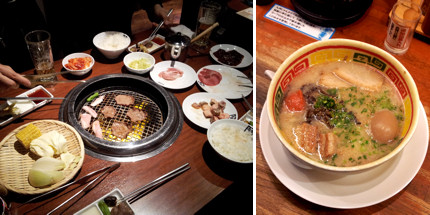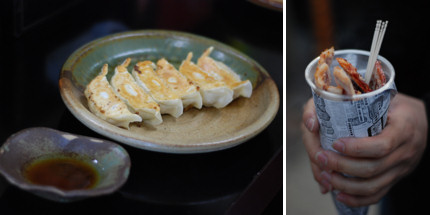A foodie’s guide to Japan
From delicious ramen and exquisite sashimi to mouth-watering street food and moreish cakes, Japan is a foodie’s paradise and quite possibly the ultimate gourmet destination. Whether you’re visiting Tokyo for a few days or venturing off the beaten track, experience fantastic food and local delicacies with Coralie Modschiedler’s Japan food guide.
Shark tales and fish markets
It’s 4.30am in the little fishing town of Katsuura, a few hours south of Osaka. There’s not a tourist in sight. As I rub my eyes and yawn uncontrollably, big fishing boats start appearing on the horizon. Before long, a frenetic scene unfolds before me, as dozens of local Japanese fishermen offload, wash, line up and weigh hundreds of freshly caught tuna. It’s a fascinating, almost mesmerising, sight. Sharks and swordfish are also in the mix, but Katsuura is most famous for its tuna catch which the tourist office claims is the largest in Japan.
 Katsuura fish market and fresh tuna sashimi for breakfast
Katsuura fish market and fresh tuna sashimi for breakfastWTG / Coralie Modschiedler
I’m only here by chance. Last night, I met an inspiring fisherman in a local restaurant near the port and after sharing his fishing tales (and how he’d caught a huge shark the day before and that’s why he was displaying its head in a bucket on the restaurant counter!), it was he who recommended I rise early to watch the fish auction. He didn’t expect me to actually do it so he looks surprised when he sees me at the market. As a treat, he offers me some fresh tuna sashimi for breakfast. The sushi breakfast I had in Tokyo a few days ago – at one of the famed restaurants next to Tsukiji Fish Market – was sensational, but this tuna sashimi far surpasses my expectations; it's so fresh, melt-in-the-mouth, delicious.
Foodie delights in the city
My experience in Katsuura is just one of many highlights from my recent trip to Japan. I have visited the country four times and have travelled from Nikko to Okinawa, and yet, every time I go, I always discover new foods. But you don’t need to venture out to small fishing towns and mountain villages to get a taste of Japan. From Michelin-starred fine dining to delectable street food, Japanese cities deliver aplenty in the food stakes. Here are a few of my favourite places I return to time and time again.
 Tokyo has plenty of delicious foodie treats from yakiniku to ramen
Tokyo has plenty of delicious foodie treats from yakiniku to ramenWTG / Coralie Modschiedler
Kyoto is just a magical place and eating in one of the traditional restaurants that line the riverfront as the sun goes down is a perfect treat after a busy day of temple hopping. The lower ground floor at the main railway station has plenty of delicious treats too.
For the ultimate eel meal, Nagoya is the place to try it: hitsumabushi (sweet eel eaten three ways) at Maruya Honten is not to be missed! If you love savoury pancakes, you have to try Osaka's takoyaki and okonomiyaki offerings. I have many more Japanese food highlights but I can't list them all here so I hope this shortlist inspires you to go and try it for yourself.
DINING TIPS
Useful phrases: Say itadakimasu ("I humbly receive") before eating and gochisosama deshita ("thank you for the meal") after finishing the meal. With drinks, always serve the person next to you first and wait for them to reciprocate. Kampai means "cheers" (never say "chin chin"; in Japanese it refers to male genitals!)
Etiquette: Don't pass food from your chopsticks to another's or plant your chopsticks in a bowl of rice – these gestures are associated with funeral rites. When it comes to slurping, it's perfectly fine to slurp when eating noodles as it means you're enjoying the food.
Tipping: There's no need for tipping (taxis, restaurants, etc) anywhere in Japan. Japanese people never tip and it might in fact be seen as rude to do so.
 Street food is popular in Japan and a great way to eat for less
Street food is popular in Japan and a great way to eat for lessWTG / Coralie Modschiedler
NEED TO KNOW
When to go: Except for Hokkaido and Okinawa, the weather in Japan is mostly temperate, with four distinct seasons. Spring and autumn are great times of year to visit, with mild temperatures, vibrant festivals and spectacular foliage (pink cherry blossoms in spring, fiery red and golden leaves in autumn). June is the main rainy season.
Getting there: A range of airlines fly to Tokyo and Osaka from the UK (KLM and Air France often offer the cheapest fares from London) but for direct flights and guaranteed comfort, fly with British Airways, Virgin Atlantic, Japan Airlines or All Nippon Airways.
Getting around: The best way to travel around Japan is by using a Japan Rail Pass (available to non-residents only). A fixed price entitles you to travel on virtually all Japan Railways trains (including most bullet trains) during the one-, two- or three-week validity of your pass. Please note you must buy your Japan Rail Pass before you travel to Japan – you will receive an ‘Exchange Order’ which you will need to exchange for the actual pass when you arrive.
Where to stay: Great alternatives to hotels in Japan include temple stays and ryokans (traditional Japanese-style hotels), where guests wear yukatas (cotton kimonos), eat traditional meals and sleep on tatami mats.
Useful reads: Japan by Rail (3rd edition, 2012) by Ramsey Zarifeh is an excellent book packed with rail information, train timetables and cultural tips. For more information on Japan and to plan your trip, read our online Japan Travel Guide and visit www.jnto.go.jp.
Do you have any Feedback about this page?
© 2026 Columbus Travel Media Ltd. All rights reserved. No part of this site may be reproduced without our written permission, click here for information on Columbus Content Solutions.









 You know where
You know where